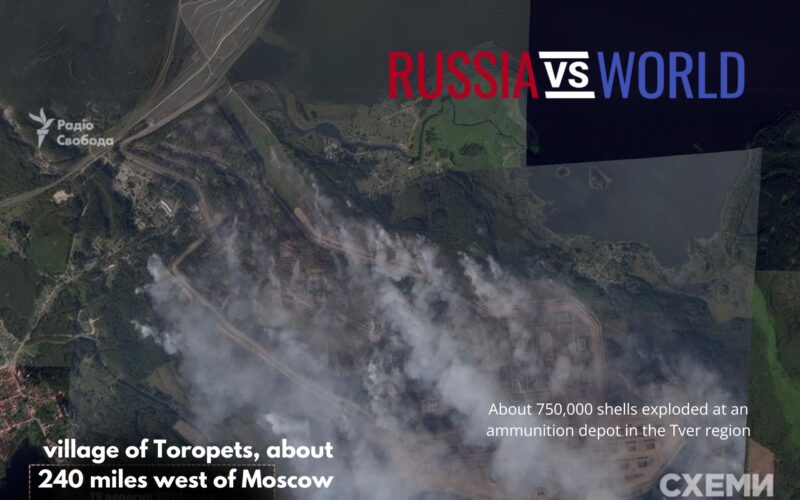The American publication Vox writes that the destruction of a large ammunition depot “causing a blast detectable from space” in Russia’s Toropets proves that Ukraine deserves continued support, as it is capable of achieving more battlefield victories if the Biden administration would allow the military to use US-made long-range weapons to strike targets deep inside Russia.
About 750,000 shells exploded at an ammunition depot in the Tver region, — Estonian intelligence. Massive russian weapons depot still burning after ukrainian drone attack according to FIRMS fire data. Estonian intelligence also believes Ukrainian strike on Russia’s Toropets will affect war’s course in coming weeks.
Ukraine’s recent drone strikes within Russian territory, including a high-profile attack on a weapons depot in the Tver region, signal a deliberate effort by Kyiv to project strength and resilience in the face of a prolonged war. On Wednesday, a Ukrainian drone reportedly hit the depot in Tver, causing an explosion so significant it was detected from space. This comes on the heels of Ukraine’s bold ground offensive into Russia’s Kursk region in August, capturing approximately 500 square miles of territory. These operations represent more than just military gains—they are part of Ukraine’s broader strategic effort to secure increased Western, particularly U.S., military aid.
The Tver strike, near the village of Toropets, some 240 miles from Moscow, underscores Ukraine’s growing operational reach. As noted by Russian military bloggers, the attack was so severe that local evacuations were ordered. Both the Tver strike and the Kursk incursion aim to shift the dynamics of the ongoing conflict in Ukraine’s favor, setting the stage for future negotiations and degrading Russia’s military capabilities. By targeting Russian morale, supply lines, and resupply capabilities, Ukraine is working to not only safeguard its territory but also bolster its bargaining position should peace talks occur—despite no negotiations being currently scheduled.
Kyiv’s argument to its allies is clear: with more advanced weaponry, it can push back against Russian forces more effectively. Ukraine’s leadership has long called for U.S. approval to use American-made long-range weapons to strike further into Russia, a request Washington has so far hesitated to grant. The Tver operation, alongside the earlier Kursk offensive, serves to demonstrate Ukraine’s potential to prevail—if only its Western allies are willing to provide the necessary support.
The timing of these actions is particularly significant, with U.S. presidential elections approaching. The Biden administration’s support for Ukraine has been robust, but Kyiv remains wary of a potential shift in U.S. policy should a change in leadership occur. Former President Donald Trump and several other Republican candidates have expressed skepticism about continuing material support for Ukraine’s war effort. In this context, Ukraine’s drone strikes are more than tactical; they are strategic signals aimed at keeping U.S. aid flowing.
Despite these tactical successes, it remains unclear whether the Biden administration will provide the long-range capabilities Ukraine seeks. While Ukraine has proven adept at using limited resources, there are significant constraints on the degree to which the U.S. is willing to be seen as escalating the conflict. Washington has been reluctant to authorize strikes deeper within Russian territory for fear of provoking a broader confrontation, a concern that continues to weigh heavily on its decision-making.
Nonetheless, as Riley Bailey, a senior researcher at the Institute for the Study of War, noted, Ukraine has maintained a consistent drone strike campaign against key logistical hubs within Russia. Targets such as oil refineries, military airfields, and ammunition depots have been hit in recent months, with the Tver strike being one of the more visible examples of success. These attacks, similar to the long-range missile strikes against Russian positions in Ukraine during the summer of 2022, are designed to disrupt Russia’s ability to mount offensive operations and defend its own territory.
The drone strikes could force Moscow to divert resources away from the Ukrainian front to shore up defenses on its own soil, spreading its forces thinner and compounding logistical challenges. As Bailey notes, sustained pressure on key Russian logistics facilities could impose operational strains reminiscent of those seen in Russia’s 2022 struggles within Ukraine.
However, even if the Biden administration were to green-light the use of longer-range missiles for deeper strikes into Russia, the strategic impact might be limited. Jennifer Kavanagh, a senior fellow at Defense Priorities, has argued that the number of critical Russian military targets within range is relatively small. Additionally, Moscow can move key assets out of reach, mitigating the impact of Ukrainian strikes. The number of long-range weapons at Kyiv’s disposal is unlikely to be sufficient for the sustained campaign necessary to decisively alter the war’s trajectory.
Despite these limitations, Ukrainian President Volodymyr Zelenskyy appears undeterred. As he prepares to present his strategy for victory to President Biden during an upcoming visit to the United States, it is clear that Kyiv’s war aims hinge on continued Western support. Zelenskyy’s plan likely includes provisions for pressuring Russia into negotiations through military means, backed by enhanced weapons capabilities and more permissive rules of engagement. Though the U.S. has been careful to avoid actions that could be seen as direct involvement in the conflict, the Ukrainian president’s case for deeper engagement is likely to focus on making Russia’s war effort as costly and unsustainable as possible.
Yet the fear of escalation remains a central concern. U.S. officials, mindful of provoking a broader confrontation, have so far opted for caution in authorizing long-range strikes on Russian soil. However, as Ambassador William Courtney, an adjunct senior fellow at the RAND Corporation, observed, Russian reactions to Ukrainian strikes have tended to focus on adaptation rather than retaliation. Thus far, Moscow has sought to adjust to Kyiv’s tactics without significantly escalating the conflict, raising questions about whether U.S. concerns about escalation are overstated.
Ultimately, Ukraine’s continued success on the battlefield depends not only on its operational ingenuity but also on its ability to maintain—and expand—Western military support. While long-range missile capabilities alone may not be a game-changer, they form a critical part of Kyiv’s broader strategy to push Russia into a weakened position, forcing it to reconsider its options at the negotiating table. As the war drags on, Ukraine’s message to its allies remains clear: with more advanced weaponry, this war can be won—on terms favorable to Ukraine.
UPD: Ukrainian drones also attacked Another massive Russian ammunition depot destroyed by Ukrainian kamikaze UAV strike. This time in Tikhoretsk the 23rd arsenal of the GRAU, near the village of Oktyabrsky located to the south of the 107th arsenal. Objective control does not yet allow us to talk about one large-scale detonation, but NASA satellites have recorded thermal signatures throughout the arsenal. Local residents report powerful explosions and repeated detonations.








